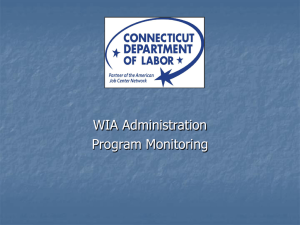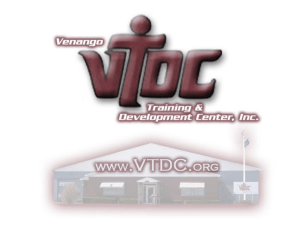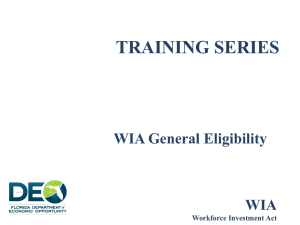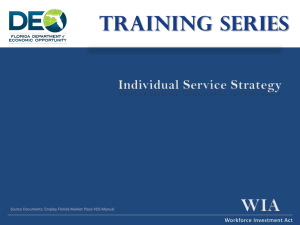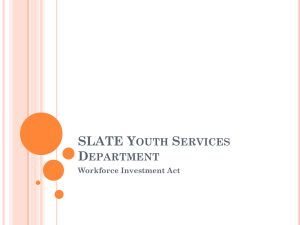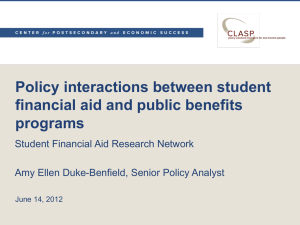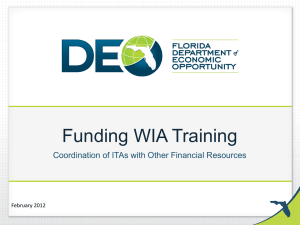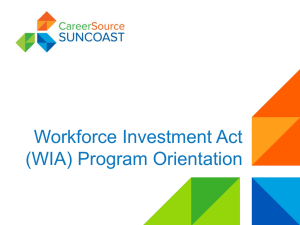(WIA) and Colorado`s Workforce Centers
advertisement
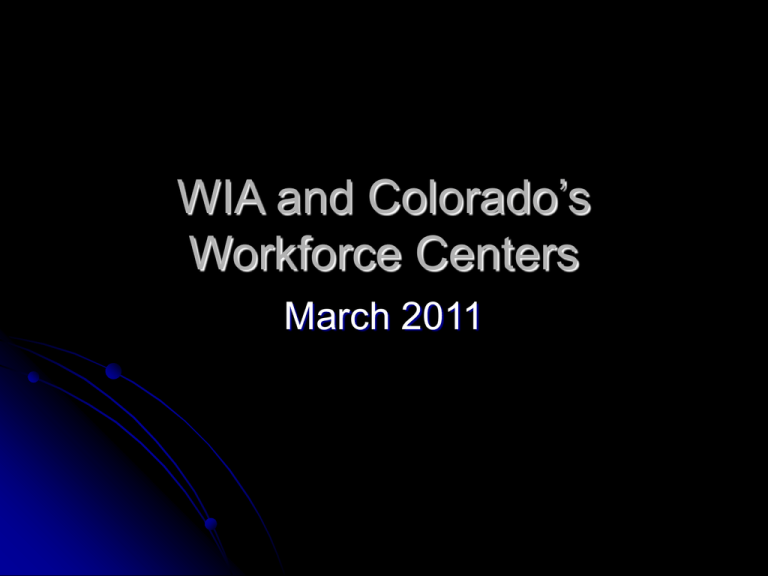
WIA and Colorado’s Workforce Centers March 2011 The Workforce Investment Act of 1998 WIA Programs – Adult, Dislocated Worker, and Youth Adult Education and Literacy Act Amendments Wagner-Peyser Act Amendments and Other Related Activities Rehabilitation Act Amendments General Provisions WIA Key Concepts Managed at the Local Level - Local Control There are nine workforce regions in the state with 11 sub-regions in the Rural Consortium Most workforce centers are operated by counties, but the Rural workforce centers are operated by the State (with two exceptions). Some workforce centers contract WIA services to community based organizations WIA Key Concepts (cont.) Local Workforce Investment Boards Each workforce region must have a board with majority business membership and representatives of education, economic development, labor and community agencies Boards provide oversight of the programs and set the strategic direction for the workforce region Boards must develop partner agreements with other providers of workforce services such as Adult Ed, Voc Rehab, TANF Work Programs, Title V Older Workers, UI, Carl Perkins/Community Colleges, HUD E&T, Community Service Block Grant E&T programs. WIA Key Concepts (cont.) One-Stop Centers (workforce centers) At least one full-service center must be operated in each region that offers most employment and training services in one physical location Collocated programs most frequently include WIA, Wagner-Peyser, TAA, VETS, TANF, Employment First, and others Centers must provide 24/7 access to all customers through on-line self-service options: www.ConnectingColorado.com Centers must provide access to disabled and limited English proficiency customers One-Stop Center Services Core Services (for all job seekers) Access to computers, copiers, and phones for selfdirected job search (resource centers) Job matching and job referrals Labor market information Work search and work readiness workshops One-on-one job search assistance, assessment, and career guidance services Referrals to intensive and training services in the one-stop and partner agencies One-Stop Center Services (cont.) Business Services (for all employers) Recruitment and screening of qualified job candidates Labor market information Job fairs and hiring events Business roundtables and workshops Paid and unpaid work experiences/internships On-the-Job training or customized training contracts Participation in SECTORS training grants One-Stop Center Services (cont.) Intensive Services (usually offered to those eligible for and enrolled in programs or grants) In-depth assessment Counseling and case management Individual employment plans Supportive services such as gas vouchers, bus passes, day care, work clothing and tools In-depth pre-vocational workshops such as Adult Basic Education, ESL, and GED preparation Special services such as tutoring, work experiences, etc. One-Stop Center Services (cont.) Training Services (must be eligible for and enrolled in a program or grant) Individual Training Accounts (ITAs) for classroom training On-the-Job Training Entrepreneurial Training Customized Training Access to discretionary grants that offer training, such as SECTORS grants WIA Adult Program (AD) Eligibility: 18 or older, citizen or authorized to work in the US, Selective Service registration (males 18-25) Veterans Priority of Service applies In need of services and can benefit from the program Not an entitlement program WIA Adult Program (AD) Requirements: When funds are limited, regions may invoke priority of service for low income and other groups Sequential delivery of core, intensive, and training services Individual Training Accounts or other training options 12 months of post program follow-up for those entering employment Performance outcomes based on entered employment, employment retention, and average wage WIA Dislocated Worker Program (DW) Eligibility: 18 or older, citizen or authorized to work in the US, Selective Service registration (males 18-25) Veterans Priority of Service applies In need of services and can benefit from the program Not an entitlement program; AND WIA Dislocated Worker Program (DW) Eligibility (one of the following) Layoff, UI eligible, & unlikely to return to previous industry or occupation; or Substantial layoff or business closure; or Loss of self-employment due to economic downturn or natural disaster; or Displaced homemaker; or UI Profiled WIA Dislocated Worker Program (DW) Requirements: Sequential delivery of core, intensive, and training services Individual Training Accounts or other training options 12 months of post program follow-up for those entering employment Performance outcomes based on entered employment, employment retention, and average wage WIA Youth Program (YT) Eligibility Ages 14 through 21 Citizen or authorized to work in the US Selective Service registration (males 1825 years of age) In need of services and can benefit from the program/not an entitlement program Veterans Priority of Service applies to those 18 and older; AND WIA Youth Program (YT) Eligibility (cont.) Low Income AND One or more of the following: Deficient in basic literacy skills School dropout Homeless, runaway, or foster child Pregnant or parenting Offender Requires additional assistance to complete education or hold employment (locally defined) WIA Youth Program (YT) Eligibility (cont.) 5% Low Income Exemption if the client meets one or more of the following: School dropout Basic skills deficient Educational attainment 1 or more grades below grade level appropriate to age Pregnant or parenting Disabled including learning disabilities Homeless or runaway Offenders Facing serious barriers to employment (locally defined) WIA Youth Program (YT) Requirements Case managers must provide: Objective assessment Development of individual service strategy (ISS) Preparation for post secondary and/or employment opportunities Links to academic and occupational learning opportunities WIA Youth Program (YT) Requirements (cont.) Program operators must procure (or make available) the following youth program elements: Tutoring Alternative secondary school opportunities Paid and unpaid work experiences Summer employment opportunities Leadership development Occupational skills training Supportive Services Adult Mentoring 12 months of post program follow-up Comprehensive guidance and counseling WIA Youth Program (YT) Requirements (cont.) 30% of more of local WIA Youth funds must be spent on services to out-of-school youth Performance outcomes based on: Literacy/Numeracy Gains Placement Rate (into employment, military or post secondary school) Attainment of a Degree or Certificate WIA Discretionary Grants Can be awarded from state level funds or USDOL national funds (such as the Career Pathways through Education and Employment grant that funds your initiative). Eligibility Age, citizen or authorized to work in the US, Selective Service registration (males 18-25 years of age) Veterans Priority of Service applies Additional eligibility factors defined by the grant or source of funds Program elements and performance outcomes defined by grant requirements How is WIA Funded? Congress appropriates new funds each year that are formula-allocated to states by the US Department of Labor The WIA program year is July 1 through June 30 Funds are used for 3 years at the state level, but only 2 years at the local level States keep some of the money, but most funds are formula-allocated to regions Statewide WIA Activities Administered by CDLE Layoff Assistance Program Discretionary grants awarded to workforce regions and contractors Program monitoring and fiscal auditing functions Statewide customer database, program and financial reporting systems, and eligible training provider list Staff that administer special grants from the US Department of Labor and partner agencies Complying with the Law States must implement a system of monitoring that insures compliance with all fiscal, administrative, and programmatic requirements of: WIA – the law and regulations Federal policies (TEGLs) OMB Circulars and regulations State policies (PGLs) Local policies approved by local boards Other laws such as those related to employment, non-discrimination, etc. Grant specific requirements What do we know? WIA involves the implementation of a statewide system of one-stop centers offering access to multiple employment and training programs WIA requires working with many partners, and it has a complex set of eligibility, program, fiscal, and administrative requirements There is much to learn in order to successfully implement WIA programs and grants What additional learning resources are available? www.doleta.gov (laws, regulations, TEGLs – USDOL policies, and more) www.workforce3one.org (WIA best practices, webinars, and more) www.colorado.gov/CDLE/PGL (state policies) www.e-colorado.org (portal to access a wide variety of employment and training resources) Workforce Development Programs subject matter experts (Angel Moreno) Thank You Nina Holland Manager Policy and Technical Assistance CDLE (303) 318-8806 nina.holland@state.co.us
